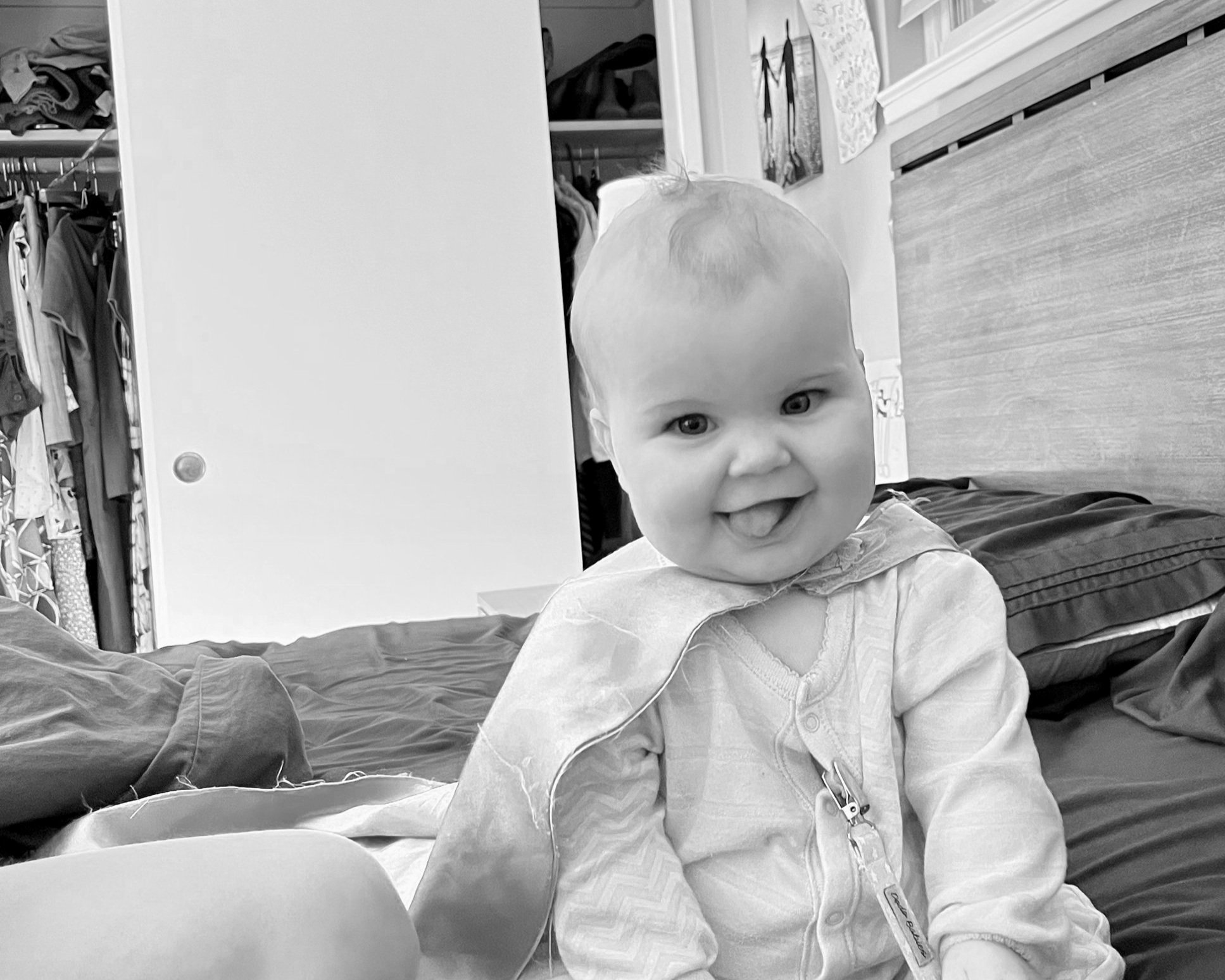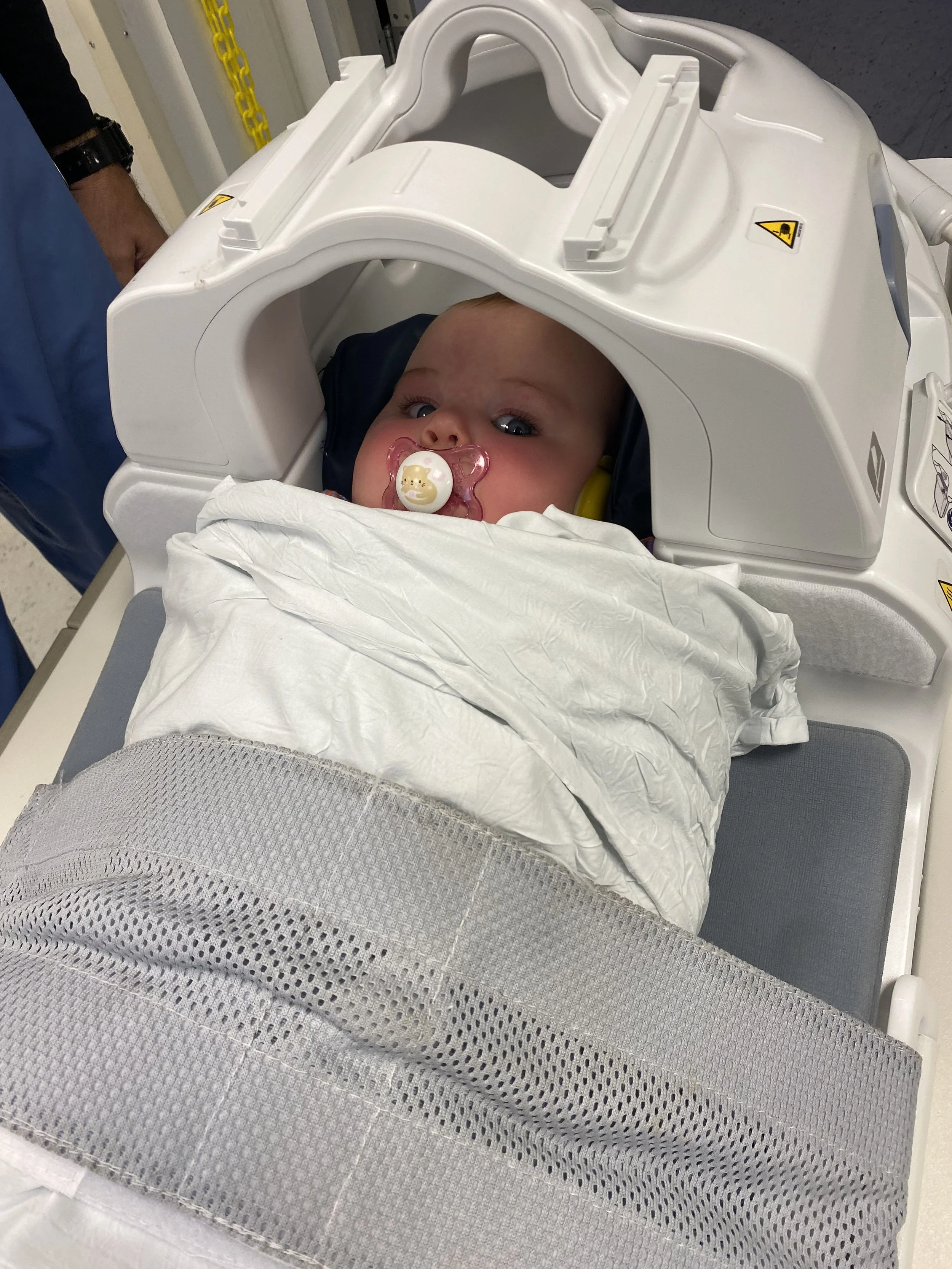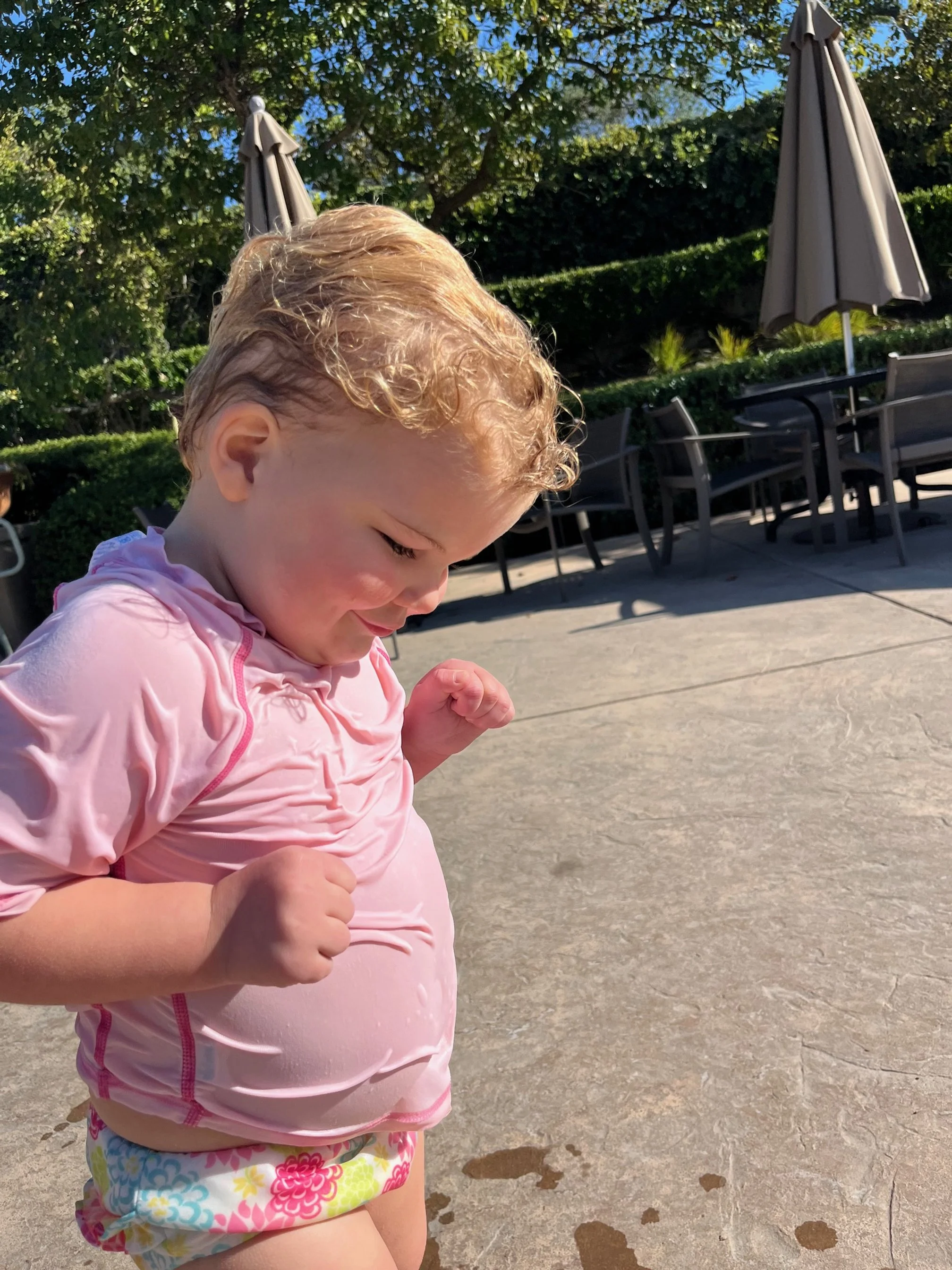
Meet Lucy…
…our PGAP3 Unicorn.

Meet Lucy…
…our PGAP3 Unicorn.
My daughter Lucy absolutely loves the water - whether it’s a warm bath or a refreshing pool, that girl will stay in and “splash splash splash” with her sisters and dad forever.
On a recent family vacation, she got a little cold, but I knew something was up because she wasn’t interested in the pool and seemed especially tired, fussy, and floppy. And when we came home, things got worse.
Our normal routine on school days was to lay her next to her sleeping 7-year-old sister – her cute babbles were the only way to get her night owl, big sis, to wake up in a good mood before school. However, over the next few days, she wasn’t babbling much and her older sister complained, “I can’t get Goose to smile at all this morning.”
We soon met with the neurologists at Stanford’s Lucille Packard Children’s Hospital, who were also concerned. They conducted an extensive workup including a brain MRI, EEG (for seizures), spinal taps (for infections and neurotransmitter problems), and EMG / nerve conduction studies, all of which were reassuring and couldn’t explain why she was seemingly so off her baseline.
After about a week, however, the symptoms mostly went away and she returned to her babbling and smiley self, albeit a bit less strong than before. To be thorough, though, broad genetic testing was sent off.
One month later, we received the text no parent ever wants to get: “Lucy’s genetic tests are back and I’m concerned. Let’s meet in an hour.” No surprise, I spent that hour in the bathtub splashing with Lucy, trying to distract us all in her happy place.
Then came the shocking news that Lucy has two bad copies of her PGAP3 gene, one of the many genes involved in sticking important molecules to cells and in cell communication. She has one tiny amino acid difference in one tiny protein – yet, it’s an essential one. And when she’s sick, even with a common cold, her cells work and communicate even less effectively.
“Her diagnosis is extremely rare, with only a handful of other patients known worldwide. We weren’t the only ones shocked”
Her diagnosis is extremely rare, with only a handful of other patients known worldwide. We weren’t the only ones shocked; her pediatric neurologist also never suspected, given Lucy's overall mild symptoms, that she would be delivering such a devastating diagnosis.
We were told that there is currently no cure and no treatment, and that she will likely suffer from low muscle tone and ataxia, have moderate to severe intellectual disability, develop autistic features, never develop expressive speech, and may develop intractable seizures. We looked through tears at our smiling, curious baby and defiantly didn’t believe it.
My daughter Lucy absolutely loves the water - whether it’s a warm bath or a refreshing pool, that girl will stay in and “splash splash splash” with her sisters and dad forever.
On a recent family vacation, she got a little cold, but I knew something was up because she wasn’t interested in the pool and seemed especially tired, fussy, and floppy. And when we came home, things got worse.
Our normal routine on school days was to lay her next to her sleeping 7-year-old sister – her cute babbles were the only way to get her night owl, big sis, to wake up in a good mood before school. However, over the next few days, she wasn’t babbling much and her older sister complained, “I can’t get Goose to smile at all this morning.”
We soon met with the neurologists at Stanford’s Lucille Packard Children’s Hospital, who were also concerned. They conducted an extensive workup including a brain MRI, EEG (for seizures), spinal taps (for infections and neurotransmitter problems), and EMG / nerve conduction studies, all of which were reassuring and couldn’t explain why she was seemingly so off her baseline.
After about a week, however, the symptoms mostly went away and she returned to her babbling and smiley self, albeit a bit less strong than before. To be thorough, though, broad genetic testing was sent off.
“Her diagnosis is extremely rare, with only a handful of other patients known worldwide. We weren’t the only ones shocked”
One month later, we received the text no parent ever wants to get: “Lucy’s genetic tests are back and I’m concerned. Let’s meet in an hour.” No surprise, I spent that hour in the bathtub splashing with Lucy, trying to distract us all in her happy place.
Then came the shocking news that Lucy has two bad copies of her PGAP3 gene, one of the many genes involved in sticking important molecules to cells and in cell communication. She has one tiny amino acid difference in one tiny protein – yet, it’s an essential one. And when she’s sick, even with a common cold, her cells work and communicate even less effectively.
Her diagnosis is extremely rare, with only a handful of other patients known worldwide. We weren’t the only ones shocked; her pediatric neurologist also never suspected, given Lucy's overall mild symptoms, that she would be delivering such a devastating diagnosis.
Most kids with PGAP3-CDG are markedly disabled and develop very severe symptoms in early childhood years. At 12 months, Lucy sits, pulls to stand, babbles, plays, and is working toward her first steps.
We were told that there is currently no cure and no treatment, and that she will likely suffer from low muscle tone and ataxia, have moderate to severe intellectual disability, develop autistic features, never develop expressive speech, and may develop intractable seizures. We looked through tears at our smiling, curious baby and defiantly didn’t believe it.
My daughter Lucy absolutely loves the water - whether it’s a warm bath or a refreshing pool, that girl will stay in and “splash splash splash” with her sisters and dad forever.
On a recent family vacation, she got a little cold, but I knew something was up because she wasn’t interested in the pool and seemed especially tired, fussy, and floppy. And when we came home, things got worse.
One month later, we received the text no parent ever wants to get: “Lucy’s genetic tests are back and I’m concerned. Let’s meet in an hour.” No surprise, I spent that hour in the bathtub splashing with Lucy, trying to distract us all in her happy place.
Then came the shocking news that Lucy has two bad copies of her PGAP3 gene, one of the many genes involved in sticking important molecules to cells and in cell communication. She has one tiny amino acid difference in one tiny protein – yet, it’s an essential one. And when she’s sick, even with a common cold, her cells work and communicate even less effectively.
“Her diagnosis is extremely rare, with only a handful of other patients known worldwide. We weren’t the only ones shocked”
Our normal routine on school days was to lay her next to her sleeping 7-year-old sister – her cute babbles were the only way to get her night owl, big sis, to wake up in a good mood before school. However, over the next few days, she wasn’t babbling much and her older sister complained, “I can’t get Goose to smile at all this morning.”
We soon met with the neurologists at Stanford’s Lucille Packard Children’s Hospital, who were also concerned. They conducted an extensive workup including a brain MRI, EEG (for seizures), spinal taps (for infections and neurotransmitter problems), and EMG / nerve conduction studies, all of which were reassuring and couldn’t explain why she was seemingly so off her baseline.
After about a week, however, the symptoms mostly went away and she returned to her babbling and smiley self, albeit a bit less strong than before. To be thorough, though, broad genetic testing was sent off.
Her diagnosis is extremely rare, with only a handful of other patients known worldwide. We weren’t the only ones shocked; her pediatric neurologist also never suspected, given Lucy's overall mild symptoms, that she would be delivering such a devastating diagnosis.
Most kids with PGAP3-CDG are markedly disabled and develop very severe symptoms in early childhood years. At 12 months, Lucy sits, pulls to stand, babbles, plays, and is working toward her first steps.
We were told that there is currently no cure and no treatment, and that she will likely suffer from low muscle tone and ataxia, have moderate to severe intellectual disability, develop autistic features, never develop expressive speech, and may develop intractable seizures. We looked through tears at our smiling, curious baby and defiantly didn’t believe it.
“We are still defiant, and there is good reason to believe there is a lot of hope for Lucy.”
Unfortunately, the genetic diagnosis is true. Equally unfortunately, given that so few people have this genetic disorder, there are no trials anywhere in the world for PGAP3 and there is no active research on developing a therapy for children with PGAP3.
However, we are still defiant, and there is good reason to believe there is a lot of hope for Lucy.
“We are still defiant, and there is good reason to believe there is a lot of hope for Lucy.”
Unfortunately, the genetic diagnosis is true. Equally unfortunately, given that so few people have this genetic disorder, there are no trials anywhere in the world for PGAP3 and there is no active research on developing a therapy for children with PGAP3.
However, we are still defiant, and there is good reason to believe there is a lot of hope for Lucy. One of her copies of PGAP3 is a new variant, which may be slightly milder than cases described previously.
“We are still defiant, and there is good reason to believe there is a lot of hope for Lucy.”
Unfortunately, the genetic diagnosis is true. Equally unfortunately, given that so few people have this genetic disorder, there are no trials anywhere in the world for PGAP3 and there is no active research on developing a therapy for children with PGAP3.
However, we are still defiant, and there is good reason to believe there is a lot of hope for Lucy. One of her copies of PGAP3 is a new variant, which may be slightly milder than cases described previously.
“The sky is the limit to what we can do for her.”
Few children with this disorder have ever been diagnosed so young or had such a mild initial presentation. Most importantly, Lucy is young, and as my grandfather would say, there is light behind those eyes – she is curious, loving, chatty, and has not yet developed any of the more serious features of this syndrome.
She is truly an N-of-1, with a novel variant and a novel set of life circumstances. No child in the world with her condition has had the opportunity to have an effective treatment so early in life, which means that the sky is the limit to what we can do for her.
“The sky is the limit to what we can do for her.”
Few children with this disorder have ever been diagnosed so young or had such a mild initial presentation. Most importantly, Lucy is young, and as my grandfather would say, there is light behind those eyes – she is curious, loving, chatty, and has not yet developed any of the more serious features of this syndrome.
She is truly an N-of-1, with a novel variant and a novel set of life circumstances. No child in the world with her condition has had the opportunity to have an effective treatment so early in life, which means that the sky is the limit to what we can do for her.
“The sky is the limit to what we can do for her.”
Few children with this disorder have ever been diagnosed so young or had such a mild initial presentation.
Most importantly, Lucy is young, and as my grandfather would say, there is light behind those eyes – she is curious, loving, chatty, and has not yet developed any of the more serious features of this syndrome.
She is truly an N-of-1, with a novel variant and a novel set of life circumstances. No child in the world with her condition has had the opportunity to have an effective treatment so early in life, which means that the sky is the limit to what we can do for her.
“No pharma company, government, or investor is interested in funding this research – it has to be us, together with you.”
Because there are simply not enough kids known to have Lucy’s genetic disorder, no pharma company, government, or investor is interested in funding this research – it has to be us, together with you. We are tackling her treatment from multiple angles - supplements, drug repurposing, and gene therapy. The work done for her treatment will hopefully lead to treatments for the dozens of children suffering from this condition around the world. Please help us fund this research and give Lucy and other children with PGAP3 the gifts of speech, walking, and a life without seizures.
- Geri Landman | Co-founder, Pediatrician, and Mother
“No pharma company, government, or investor is interested in funding this research – it has to be us, together with you.”
Because there are simply not enough kids known to have Lucy’s genetic disorder, no pharma company, government, or investor is interested in funding this research – it has to be us, together with you. We are tackling her treatment from multiple angles - supplements, drug repurposing, and gene therapy. Lucy will be the N-of-1, but the work done for her treatment will hopefully lead to treatments for the dozens of children suffering from this condition around the world. Please help us fund this research and give Lucy the gifts of speech, walking, and a life without seizures.
- Geri Landman | Co-founder, Pediatrician, and Mother
“No pharma company, government, or investor is interested in funding this research – it has to be us, together with you.”
Because there are simply not enough kids known to have Lucy’s genetic disorder, no pharma company, government, or investor is interested in funding this research – it has to be us, together with you. We are tackling her treatment from multiple angles - supplements, drug repurposing, and gene therapy. Lucy will be the N-of-1, but the work done for her treatment will hopefully lead to treatments for the dozens of children suffering from this condition around the world. Please help us fund this research and give Lucy the gifts of speech, walking, and a life without seizures.
- Geri Landman | Co-founder, Pediatrician, and Mother
Fall 2024 Update
Lucy has been through a lot in the 2.5 years since her diagnosis. We have tried many supplements, medications including ketamine, and diets including ketogenic diet, to help her physical and cognitive function. Many have seemed to make a difference temporarily, but none have shown lasting improvement. This may just be the nature of her disease - skills come and go, and there is a lot of neuroinflammation. One day she can clap, then she can’t for months, then one day it’s back! Sometimes she can sign “more” and other days she struggles to communicate at all. Some mornings she walks right to the kitchen, but most she ricochets off the walls and falls multiple times on her way there. She’s suffered a lot with GI problems related to her slow and sensitive gut, as well as many rounds of ear infections, but luckily we seem to be on top of these problems recently and she is happy and mostly comfortable. Her smile lights our world. She tries so hard at her weekly PT, OT, and speech therapy. She loves music, and still loves the water. She luckily has not yet developed seizures. We cannot wait for gene therapy, which we continue to believe is the definitive therapy for PGAP3!








